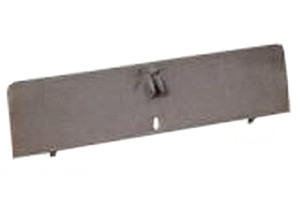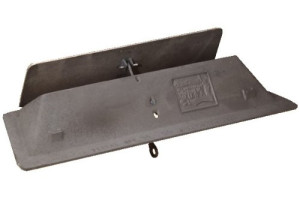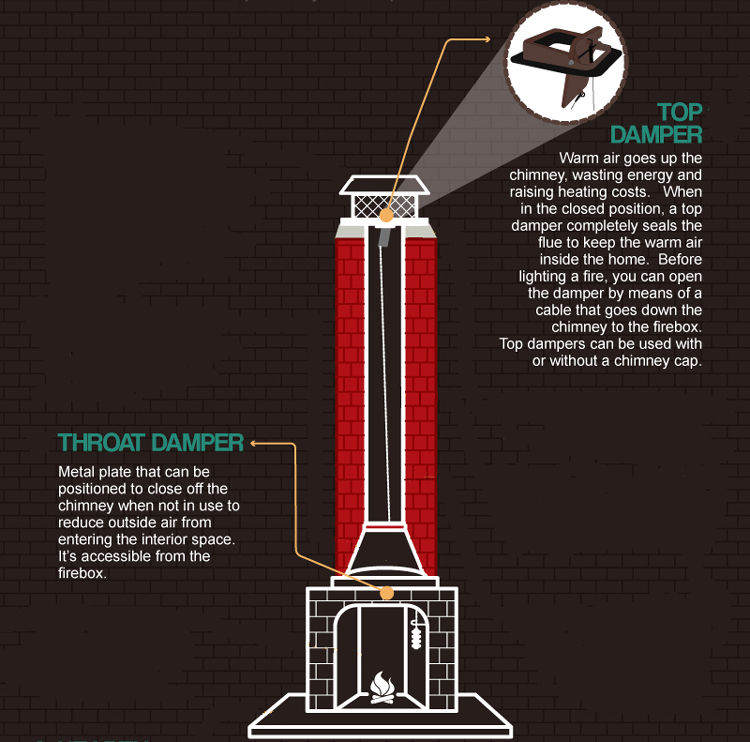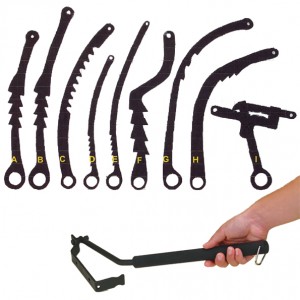Fireplace dampers or chimney dampers, components of your fireplace, help regulate airflow and draft for fireplaces. They are, therefore, opened or closed with a damper handle.
About chimney and fireplace dampers
Most fireplaces have a throat damper, sometimes called a lower damper, just above the firebox. It is like a valve, or trapdoor, between the firebox and the flue. When the fireplace is not in use, it should be closed, to prevent warm air from the home’s heating system from escaping up the chimney. Before starting a fire, it is important to open the fireplace damper to prevent smoke from backing up in the home. Once a fire is burning, you can “fine-tune” the draft or upward flow to make your firewood last longer, by closing the damper a small amount at a time. Stop and open it a bit if you smell smoke. (Not sure how to open or close your damper?)
Throat dampers are located right above the heat of your fire. Rapid changes in temperature of the metal can warp it over time. If water has come into your chimney in the past, the throat damper may be rusted out.
Replacing the whole throat damper (framework and valve plate) is possible for handy homeowners, but if you do not consider yourself the handy-person type, hire a chimney sweep to do it. However, replacing just the valve plate part of the damper is easy. Throat dampers come in 24″, 30″, 33″, 36″ and 42″ widths. The value plates are not as wide as their frameworks. Measure your existing valve plate before purchasing a replacement.
 Throat damper: valve plate only |
 Throat damper: framework and valve plate |
These throat dampers, however, are usually just metal flaps that do not close very tightly, so they can allow heat and energy dollars to escape. Whether or not you have a throat damper, a top damper is a good investment.
Why a chimney top-sealing damper?
A top damper installs at the top of your chimney and is opened and closed by means of a stainless steel cable. The cable is dropped down the flue and equipped with a handle so you can open and close it. A latch installed just inside the firebox allows you to lock it open or closed. Top dampers seal much more tightly than the throat ones, lowering home heating costs. They pay for themselves in a few years.
Some top-sealing dampers, like the Lyemance, offer a chimney cap designed to slip over the damper and attach to the flue tile. Other brands have a built-in chimney cap or no chimney cap at all. If your home has a top-sealing one but no chimney cap, you can install a top mount chimney cap that fits over the damper and the flue tile and is attached to the chimney crown with screws. Just be sure the screen mesh of the chimney cap is tall enough to allow the top damper to open completely.
Handles for Fireplace Dampers
The handles of throat dampers pass through the face of the fireplace and connect to the fireplace damper plate. This position is directly in line with the upward flow of hot exhaust gases. For this reason, these handles often rust so badly that they no longer work. You can remove your rusted handle by removing the pin that attaches it to the plate. Match it up with the drawings of replacement damper handles below when ordering a replacement.

